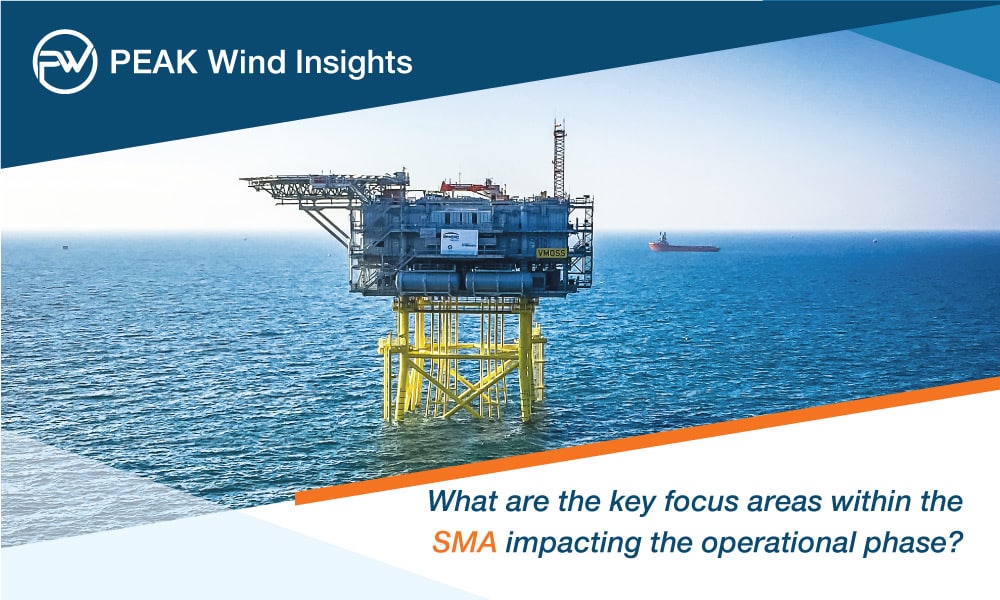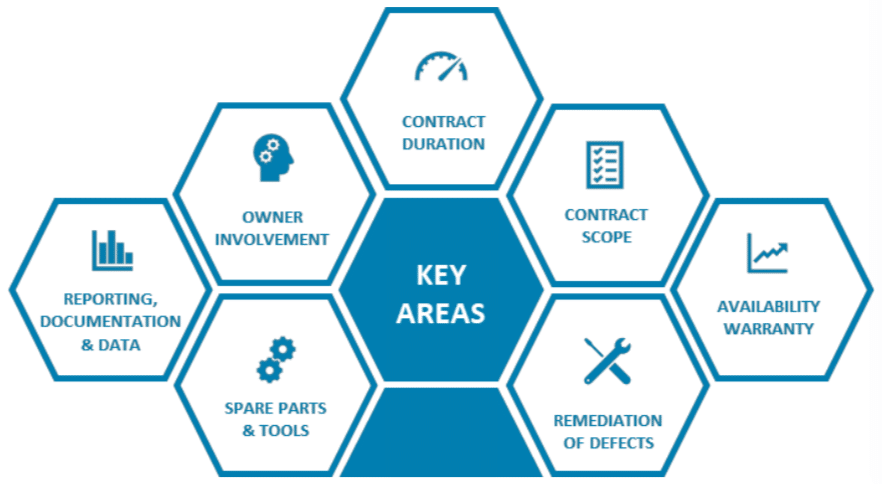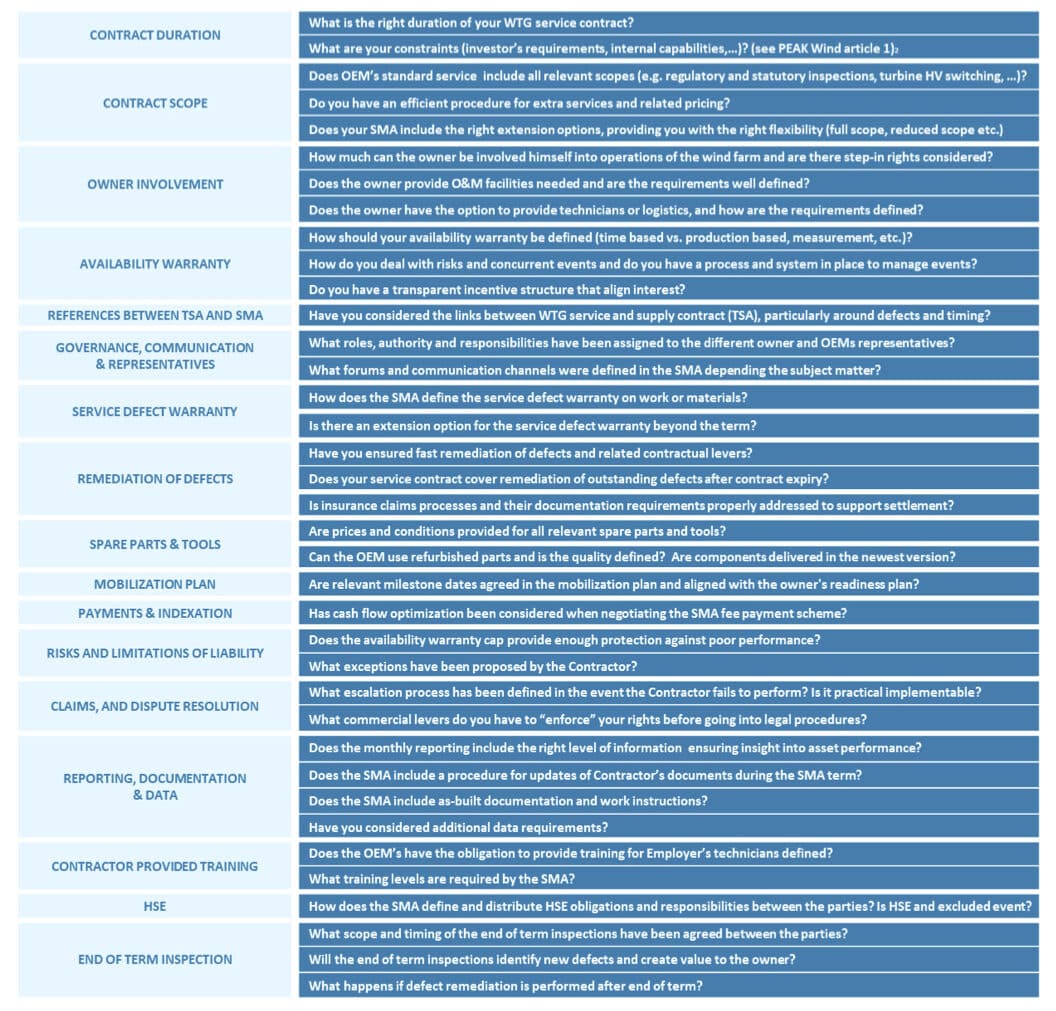
Why read this article?
Operational expenditure (‘OPEX’) can equate to 25-30% of the total lifetime cost of a wind farm – even more when it concerns an offshore asset. The majority of these costs fall under one single contract – the turbines’ Service and Maintenance Agreement (‘SMA’)* . Considering the large impact of the SMA on the Owner’s overall business case, it is crucial to have a well-defined and optimized Contract.
This article looks at the SMA contract from the Owner’s perspective and addresses key questions that often arise during SMA negotiations. In order to optimize your SMA, there are many different levers that must be considered (see table 1 for an extensive list).
In this article, we focus and elaborate on the 8 key areas displayed in the figure below.

Figure 1. Key areas within SMA impacting the operational phase
Contract Duration
When defining the duration of your SMA, the Original Equipment Manufacturer (‘OEM’) often pushes for long-term service agreements. But is that the right solution for your wind farm project? Is a full-scope service agreement needed after expiry of the TSA warranties? How do you want to operate your wind farm asset during its full lifetime? Your SMA should not only support your specific project business case, but also fit the long-term portfolio strategy and securing the right options in the SMA is paramount. . For example, incorporating an exit fee option or explicit options for reduced scope services which keep the contractual flexibility towards future optimization.
Contract Scope
The scope of an SMA is dependent on the amount of Owner’s risk you are prepared to take. The SMA scope can span from a full scope fixed fee contract to a limited scope with multiple variable fee services. It is important to consider that the wind industry and options for cost-effective turbine servicing will mature during the duration of an SMA which provides opportunities to improve the overall contractual set-up. It is therefore key to build in options for changing the scope to ensure flexibility towards cost optimization in the long-term
Owner Involvement
Deciding on scope requires decisions about the level of Owner involvement. Who should provide logistics? Should the supply of a certain number of technicians be under the Owner’s responsibility? Does the Owner have the right to participate in technical investigations or root cause analysis? The level of Owner involvement must be in line with the overall O&M strategy. For example, considering a full operations take-over after End-of-Warranty requires significant Owner involvement to ensure a smooth take-over and enable the Owner to independently operate the wind farm.
Availability Warranty
A high warranted availability level is not everything. Too often we see a significant difference (e.g. +2%-points) between the warranted yield of the turbines and the actual yield due to contractual carveouts. Some pertinent questions that need to be addressed are: Who is responsible for accessibility risks due to weather conditions? What is considered force majeure (e.g. is lightning risk covered by the availability warranty)? How does the warranted availability treat concurrent events? How do you track the allocation of downtime between the OEM and Owner and is it transparent? And last but not least, have you agreed on a fair and transparent availability incentive structure?
Spare Parts & Tools
Spare parts and tools are often overlooked areas. How do you ensure that spare parts can be supplied during and after the SMA period and at what cost? Should the Owner purchase an initial spare parts stock? Or is a lead-time fee concept the right solution? As an Owner, you must ensure the price for spare parts is agreed as a part of the SMA and secure spare parts supply for the lifetime of the asset.
Reporting, Documentation and Data
Having the right level of reporting, documentation and data access is key to profitably operating a wind farm. Do you already know how you want to operate after SMA expiry? If you want to keep the flexibility for selecting another third party to operate your wind farm, then it’s imperative to incorporate all the necessary requirements pertaining to reporting, documentation and data access into your contracts. Does your SMA provide you with the required history on defects and replacement parts, data access and service conducted to safely and efficiently hand-over the service work to a third party?
SMA interface with Turbine Supply Agreement (TSA)
The Defect and warranty liabilities under the TSA and the SMA are contractually distinct but often complement each other. Have you considered how this potentially impacts your business case certainty? E.g., are you sufficiently covered against serial defects or main component failures? Or what happens if the SMA expires after the TSA warranty? Both contracts are strongly interlinked and must be assessed holistically.
Remediation of Defects
It is often not clear under which contract defects are remedied. In the operational phase, the counterpart is often the OEM’s SMA contract manager, but remediation is often governed by the TSA. Understanding the links between the SMA and TSA contracts is critical as well as an appreciation for the different escalation options that each contract offers. It is not uncommon to see turbines standing still because of ongoing discussions on defect responsibility. To maximize yield, efficient and effective defect remediation must be the priority with discussions on contractual liability and commercial responsibility following after. It is also important to consider who is liable for downtime losses for Defects that are first remedied after the expiry of the SMA Availability Warranty.
Extensive list of issues and questions to be addressed during SMA contracting
Below list provides a more comprehensive list of strategic and operational questions to be considered during the negotiations with the OEM:
Table 1. Key questions to ask when negotiating a SMA

Is Turbine Service Contracting in the US different?
There are considerable differences between negotiating these agreements in mature markets, such as Europe, and new markets, such as the US.
Learn more about negotiating your turbine service agreements in a US context
Keep in mind…
- The SMA is key for optimizing your lifetime business case – OPEX accounting for 25-30%.
- The selection of a SMA scope very much depends on the Owner operations strategy and business model.
- A well-defined yield warranty ensures that the Owner and OEMs incentives are aligned, and fewer contractual control measures are required.
Want to learn more about successful operations?
Just reach out to us, we are always happy to answer your questions and get into discussions on optimized operations and asset management!
Kristoffer Eriksen | Chief Consultant and Country Director US | Get in touch
Lars Conradsen | Co-founder and Head of Technology | Get in touch
